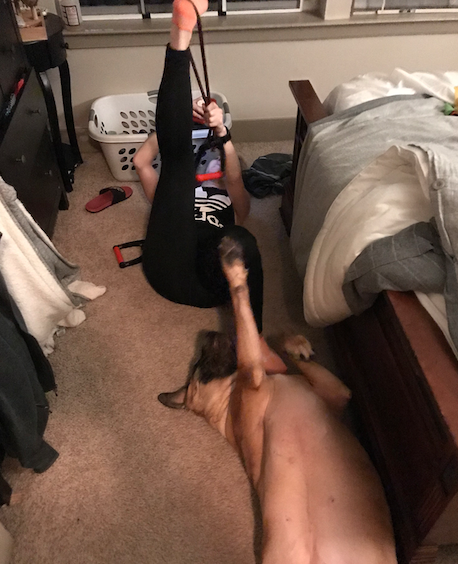Pelvic Floor PT: Not Just Kegels
The first time I heard of pelvic floor physical therapy, my best friend told me her doctor recommended she try it several months after delivering her first child vaginally. Unsurprisingly, a lot of women experience changes postpartum ranging from uncomfortable sex to peeing a little when they laugh.
Of course, after her first appointment, I was morbidly curious and wanted to know all the details of what pelvic PT entailed.
My curiosity is not uncommon. Later when I was talking about my endo experience on Instagram, literally EVERYONE wanted to hear about pelvic floor PT. Although it makes perfect sense that any set of muscles might require some maintenance after a trauma of sorts, and the pelvic muscles are no exception, no one seems to talk about pelvic floor PT, so no one knows much about what goes on with it.
The second time pelvic floor PT floated into my consciousness was when I had my first consultation with the endo specialist who performed my second surgery for endometriosis. One of the hallmarks of a doctor who knows their endo shit (in my unprofessional opinion) is approaching the disease from all angles, not just a surgical or pharmacological angle. These are the doctors who understand endo is a whole-body, chronic disease, one that manifests differently in different patients and therefore requires a multifaceted battle plan.
In addition to dietary and lifestyle recommendations, my doctor wanted me to find a good pelvic floor PT and go for two or three sessions prior to surgery, and then once healed, begin to see a PT regularly after surgery.
If you’re reading this blog, I’m probably preaching to the choir when I say the female reproductive system and the pelvic floor muscles are…complex, to say the least. That means pelvic floor PT can look different for everyone. What I was going for was totally different than what my bestie had gone for a year earlier.
For me (and many other endo patients), my doctor recommended PT because after a five-minute exam, she told me my pelvic muscles were extremely tight. I should note that I believe I have a pretty good sense of body awareness after years of working out somewhat more than the average bear and the odd array of medical problems I’ve faced. And yet, I had NO idea my pelvic muscles were tight, even though, you know, they’re literally a part of me.
My doctor explained that when we’re in pain, we generally tighten our muscles around the painful areas in an unconscious effort to “protect” ourselves. Imagine what you would do with your body if you were bracing for a punch to the gut. I had unconsciously been “bracing” myself against the endometriosis pain for years. My pelvic muscles were tight from the chronic tension and my posture had even suffered, likely from the many times over the years I had been curled up in a ball (or had wanted to curl up in a ball) due to the pain.
Although tension is a perfectly normal reaction to the stressor of pain, chronically, it compounds and causes more pain. My doctor wanted me to go to PT before surgery so that I could begin to separate the different types of pain I was feeling — pain from the endometriosis itself but also pain from my now-spazzy muscles.
I got a few recommendations for pelvic PTs but at that point in time I was pretty strapped for cash due to medical bills, so I went with one who was on my insurance plan. The first appointment consisted mostly of an interview, the way most new doctor visits do. The second half was a manual exam in which the PT inserted her gloved fingers into my vagina and told me to do a bunch of different things involving moving my legs in different directions and flexing and unflexing muscles while she palpated different spots.
At one point she told me to relax my muscles and waited…and waited. I thought I had. But I literally could not relax my muscles mostly because I couldn’t exactly FEEL them. She thought my lack of ability to relax was due to having mentally detached myself from an area of my body that had caused so much pain for so long.
While the first appointment with this PT was interesting, her style wasn’t exactly what my doctor and I were looking for. Over the next two sessions, she didn’t do any manual work at all. She just talked to me about theories of pain that are more cognitive than physical, how associations with previously painful stimuli cause more pain.
I edit healthcare textbooks for a living. I’ve been through my share of therapy. I get all this. Even still, this approach came a little too close to “the pain is in your head” for my liking. There was this ever-growing endometrium-like tissue spreading throughout my pelvic and abdominal organs, twisting and distorting them, bleeding and adding inflammation to my body every month. That was about to get treated and in the meantime, I COULDN’T RELAX MY OWN MUSCLES no matter how much I addressed my “thoughts and feelings” toward my period and associated pain.
So when I had my surgery and told my doctor about my PT sessions, she wasn’t thrilled that that PT hadn’t done any manual work, and when I got cleared to go back to therapy, I found a different therapist whose holistic approach, endless knowledge about pelvic pain and endo, and collaborative approach with other care providers made her a much better fit for me.
The initial appointment was similar, though my new PT checked out the alignment of my legs and the strength of the different muscles. Following that, my sessions were (and are) generally half external, half internal. During the first half, she typically massages my belly, loosening adhesions caused by endo and the scar tissue around my six surgical scars. The second half is usually internal, while she goes the same thing more or less in the vaginal canal. Both can be uncomfortable at best, painful at worst. Sometimes my pelvic muscles spasm before they can relax, and I promise you, this is not as fun as it sounds.
This PT’s approach was also much more proactive in terms of what I could do to support the sessions on my own at home. My first homework assignment was to buy a set of dilators, which looked like a set of five dildos in five different sizes. Although I did in fact buy these at Sugar in Hampden, I can’t say I find them sexy at all. Although my PT does recommend including them in foreplay, mixing in something I associate with treating my endo didn’t do much for me.
HOWEVER, when at the time when I bought these, I still used Snapchat and was infinitely proud of the moment of inspired creativity I had, having the presence of mind to take a video of sterilizing those pink dildos before using them. I’ll tell you what, now I’ll #neverforget that boiling pot of silicone dicks.
I’m so proud in fact, here is a steamy, steamy screenshot.
Now it’s been about a year and a half, and I still see my PT about every six weeks. My sessions vary slightly from time to time depending on what’s going on in my life. Sometimes she works on my thoracic spine if I’ve had a particularly painful period. When I was training for the marathon, she paid a lot of attention to my legs and hips. Tight hamstrings and glutes lead to tight pelvic muscles, fun fact.
Please ignore the messy bedroom and focus only on the cute copy cat dog. I assure you though, she does not have tight pelvic muscles.
Which reminds me, in addition to using the dilators, she also gave me a set of exercises to do every day. And no, they’re not Kegels. They’re actually not vaginal at all. They’re literally a set of stretches to keep my hamstrings, butt, and hips from getting too tight and taking my pelvic floor muscles along for the ride. When I was training for the marathon, she gave me an extra set of hip strengtheners to keep me strong on the long runs.
My PT has also been instrumental in helping me find a number of other natural tools for addressing my pain, everything from using a TENS unit to urging me to go to massage therapy, which has been a game-changer, especially during my training.
And so, since I know everyone wants to know (because I did too), that’s my story of pelvic floor PT. Like I previously mentioned, however, that’s just MY story. Pelvic floor PT treats LOTS of different conditions, not just for endo patients or postpartum patients. And I am sure pelvic PT for other conditions involve techniques totally different from the ones my PT uses for me. To read more about the conditions pelvic PT treats and different techniques, click here.
Have you tried pelvic floor PT? Is there anything else you want to know? Let me know in the comments or on Instagram; I’m an open book when it comes to my own health journey!
xo,
S



